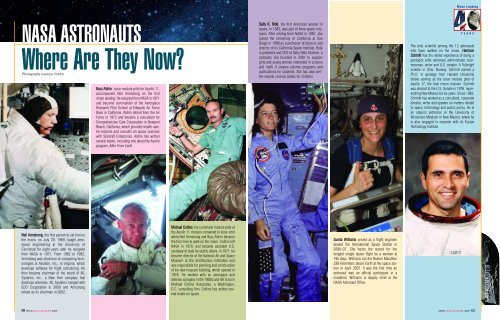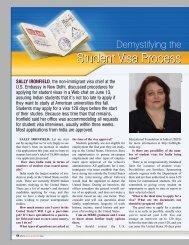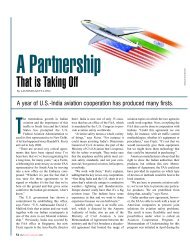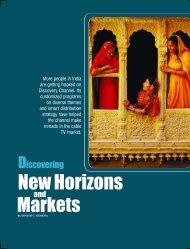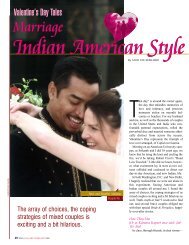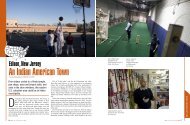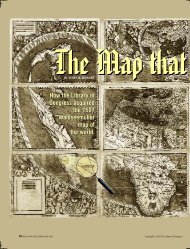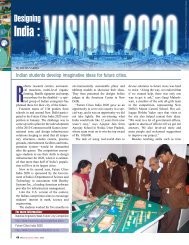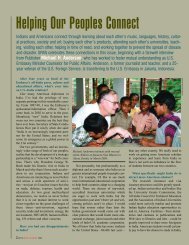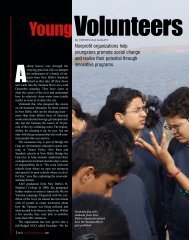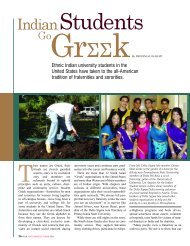NASA Astronauts: Where Are They Now?, SPAN July/August 2009
NASA Astronauts: Where Are They Now?, SPAN July/August 2009
NASA Astronauts: Where Are They Now?, SPAN July/August 2009
You also want an ePaper? Increase the reach of your titles
YUMPU automatically turns print PDFs into web optimized ePapers that Google loves.
<strong>NASA</strong> ASTRONAUTS<br />
<strong>Where</strong> <strong>Are</strong> <strong>They</strong> <strong>Now</strong>?<br />
Photographs courtesy <strong>NASA</strong><br />
Neil Armstrong, the first person to set foot on<br />
the moon, on <strong>July</strong> 20, 1969, taught aerospace<br />
engineering at the University of<br />
Cincinnati for eight years after he resigned<br />
from <strong>NASA</strong> in 1971. From 1982 to 1992,<br />
Armstrong was chairman of computing technologies<br />
at Aviation, Inc., in Virginia, which<br />
develops software for flight scheduling. He<br />
then became chairman of the board of AIL<br />
Systems, Inc., a New York company that<br />
develops antennas. AIL Systems merged with<br />
EDO Corporation in 2000 and Armstrong<br />
retired as its chairman in 2002.<br />
Buzz Aldrin, lunar module pilot for Apollo 11,<br />
accompanied Neil Armstrong on the first<br />
moon landing. He resigned from <strong>NASA</strong> in 1971<br />
and became commander of the Aerospace<br />
Research Pilot School at Edwards Air Force<br />
Base in California. Aldrin retired from the Air<br />
Force in 1972 and became a consultant for<br />
Comprehensive Care Corporation in Newport<br />
Beach, California, which provides health care.<br />
He lectures and consults on space sciences<br />
with Starcraft Enterprises. Aldrin has written<br />
several books, including one about the Apollo<br />
program, Men From Earth.<br />
Michael Collins, the command module pilot of<br />
the Apollo 11 mission, remained in lunar orbit<br />
while Neil Armstrong and Buzz Aldrin became<br />
the first men to walk on the moon. Collins left<br />
<strong>NASA</strong> in 1970, and became assistant U.S.<br />
secretary of state for public affairs. In 1971, he<br />
became director of the National Air and Space<br />
Museum at the Smithsonian Institution and<br />
was responsible for planning and construction<br />
of the new museum building, which opened in<br />
1976. He worked with an aerospace and<br />
defense company in the 1980s and left to form<br />
Michael Collins Associates, a Washington,<br />
D.C. consulting firm. Collins has written several<br />
books on space.<br />
Sally K. Ride, the first American woman in<br />
space, in 1983, was part of three space missions.<br />
After retiring from <strong>NASA</strong> in 1987, she<br />
joined the University of California at San<br />
Diego in 1989 as a professor of physics and<br />
director of its California Space Institute. Ride<br />
is president and CEO of Sally Ride Science, a<br />
company she founded in 2001 to support<br />
girls and young women interested in science<br />
and math. It creates science programs and<br />
publications for students. She has also written<br />
several science books for children.<br />
Sunita Williams served as a flight engineer<br />
aboard the International Space Station in<br />
2006-07. She holds the record for the<br />
longest single space flight by a woman at<br />
195 days. Williams ran the Boston Marathon<br />
338 kilometers above Earth at the space station<br />
in April 2007. It was the first time an<br />
astronaut was an official participant in a<br />
marathon. Williams is deputy chief at the<br />
<strong>NASA</strong> Astronaut Office.<br />
The only scientist among the 12 astronauts<br />
who have walked on the moon, Harrison<br />
Schmitt has the varied experience of being a<br />
geologist, pilot, astronaut, administrator, businessman,<br />
writer and U.S. senator. A Fulbright<br />
scholar in Oslo, Norway, Schmitt earned a<br />
Ph.D. in geology from Harvard University<br />
before serving as the lunar module pilot of<br />
Apollo 17, the final moon mission. Schmitt<br />
was elected to the U.S. Senate in 1976, representing<br />
New Mexico for six years. Since 1982,<br />
Schmitt has worked as a consultant, corporate<br />
director, writer and speaker on matters related<br />
to space, technology and public policy. He is<br />
an adjunct professor at the University of<br />
Wisconsin-Madison in New Mexico, where he<br />
is also engaged in research with its Fusion<br />
Technology Institute.<br />
10 <strong>SPAN</strong> JULY/AUGUST <strong>2009</strong> <strong>SPAN</strong> JULY/AUGUST <strong>2009</strong> 11<br />
Moon Landing<br />
Y E A R S<br />
ASTRONAUTS
Those Who Did Not Return<br />
Three astronauts died when a flash fire broke<br />
out at Cape Canaveral, Florida on January<br />
27, 1967 during a full dress rehearsal for<br />
Apollo 1.<br />
From left: Virgil I. “Gus” Grissom, commander;<br />
Edward H. White, command pilot;<br />
and Roger B. Chaffee, pilot.<br />
The crew of the Challenger space shuttle<br />
died when their spacecraft exploded during<br />
launch from the Kennedy Space Center in<br />
Florida on January 28, 1986.<br />
Front row from left: Michael J. Smith, pilot;<br />
Francis R. (Dick) Scobee, commander; Ronald<br />
E. McNair, mission specialist. Back row from<br />
left: Ellison S. Onizuka, mission specialist;<br />
Sharon Christa McAuliffe, school teacher;<br />
Gregory B. Jarvis, payload specialist; and<br />
Judith A. Resnik, mission specialist.<br />
On February 1, 2003, the space<br />
shuttle Columbia disintegrated during<br />
re-entry over Texas, killing all<br />
seven crew members.<br />
Top row from left: David M. Brown,<br />
mission specialist; Willie McCool,<br />
pilot; Michael P. Anderson, payload<br />
commander. Bottom row from left:<br />
Kalpana Chawla, mission specialist;<br />
Rick D. Husband, commander;<br />
Laurel Clark, mission specialist; and<br />
Ilan Ramon, payload specialist.<br />
12<br />
A veteran of four space flights, Eileen<br />
Collins logged over 872 hours in<br />
space. She became the first woman to<br />
pilot a space shuttle when she flew<br />
aboard STS-63 Discovery in 1995, the<br />
first flight of the Russian American<br />
Space Program. Collins earned the<br />
dual distinction of commanding a<br />
space shuttle, STS-93, in 1999. She<br />
retired from <strong>NASA</strong> in May 2006, and<br />
the following year became a director<br />
of the United Services Automobile<br />
Association, which provides insurance,<br />
online banking and financial<br />
advice to America’s military families.<br />
In 1962, John Glenn, Jr. piloted the<br />
Mercury-Atlas 6 Friendship 7 spacecraft,<br />
becoming the first American to orbit the<br />
Earth. After resigning from <strong>NASA</strong> in 1964,<br />
and retiring from the U.S. Marine Corps in<br />
1965, Glenn was a business executive<br />
until his election as senator from Ohio in<br />
1974. After a brief stint as governor to fill<br />
a vacancy, he was reelected to the Senate<br />
and continued until his retirement in<br />
1999. At 77, Glenn returned to space as<br />
payload specialist aboard Discovery in<br />
1998.<br />
John W. Young first flew into space aboard<br />
Gemini 3 in 1965 and landed on the moon<br />
during the 1972 Apollo 16 mission. He<br />
also flew the first space shuttle. Young<br />
launched into space six times, seven<br />
counting his liftoff from the moon to return<br />
to Earth. He was chief of the Astronaut<br />
Office from 1974 to 1987, with responsibility<br />
for coordinating and scheduling activities<br />
of the astronauts. In 1996, Young<br />
became associate technical director<br />
responsible for operational and safety oversight<br />
at the Johnson Space Center in<br />
Houston, Texas. He retired from <strong>NASA</strong> in<br />
2004.<br />
GEORGE SHELTON © AP-WWP/<strong>NASA</strong><br />
Mae C. Jemison, the first African American<br />
woman in space, resigned from <strong>NASA</strong> in 1993<br />
and founded a technology design company,<br />
The Jemison Group, in Houston, Texas.<br />
Projects included the use of satellite-based<br />
telecommunications to facilitate health care in<br />
West Africa. In 1994, Jemison started the<br />
Dorothy Jemison Foundation for Excellence in<br />
honor of her mother. It develops science<br />
materials for teachers and students. Jemison<br />
also founded The BioSentient Corp. in 1999<br />
which develops equipment to provide mobile<br />
monitoring of the involuntary nervous system.<br />
She has also taught at Cornell University and<br />
Dartmouth College.<br />
© AP-WWP/<strong>NASA</strong><br />
Moon Landing<br />
Y E A R S<br />
Eugene Cernan, the second American to<br />
walk in space, was also the last man to<br />
leave his footprints on the moon, as<br />
commander of Apollo 17. He left <strong>NASA</strong><br />
in 1976 and joined Coral Petroleum, Inc.,<br />
in Houston, Texas, as a vice president.<br />
His responsibilities were to develop a<br />
worldwide supply and marketing strategy.<br />
During this period, Cernan continued<br />
his education at the Wharton School of<br />
Finance and Northwestern University. In<br />
1981, he started The Cernan Corporation,<br />
a space-related technology and marketing<br />
consulting firm.<br />
<strong>SPAN</strong> JULY/AUGUST <strong>2009</strong> 13


